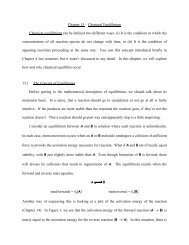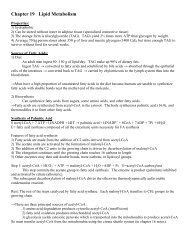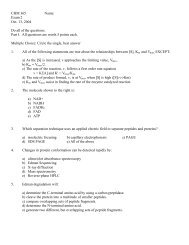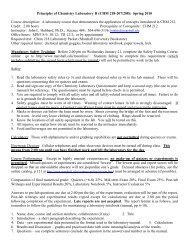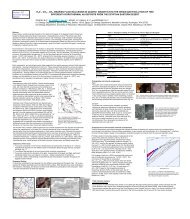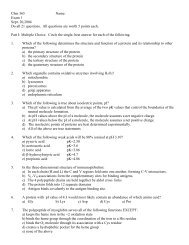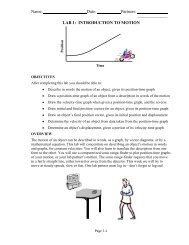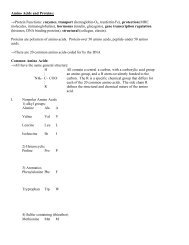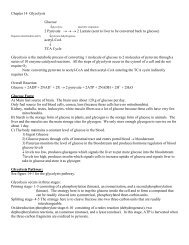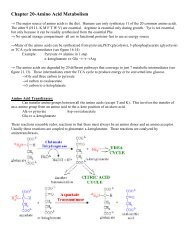Link to our lab as a pdf - College of Science - Marshall University
Link to our lab as a pdf - College of Science - Marshall University
Link to our lab as a pdf - College of Science - Marshall University
Create successful ePaper yourself
Turn your PDF publications into a flip-book with our unique Google optimized e-Paper software.
Lab Procedure<br />
6.<br />
7.<br />
8.<br />
9.<br />
<strong>to</strong> go down, but you should notice a distinct<br />
change in resistance.<br />
Place the tip <strong>of</strong> the pipette in<strong>to</strong> the liquid in the<br />
tube, but do not <strong>to</strong>uch the bot<strong>to</strong>m. Rele<strong>as</strong>e the<br />
plunger <strong>to</strong> obtain the contents <strong>of</strong> the tube.<br />
Carefully hover the tip in<strong>to</strong> the appropriate<br />
well in the gel, being careful not <strong>to</strong> <strong>to</strong>uch the<br />
gel itself.<br />
Press the plunger down slowly <strong>to</strong> dispense the<br />
sample in<strong>to</strong> the well. Do not <strong>to</strong>uch the gel itself.<br />
Remove the pipette from the well before<br />
rele<strong>as</strong>ing the plunger.<br />
Discard the used tip.<br />
10. Record the location <strong>of</strong> the sample on y<strong>our</strong> Data<br />
Collection sheet.<br />
11. Moving from left <strong>to</strong> right, repeat these steps<br />
for each sample, using a different well and tip<br />
each time.<br />
Running the Gel (45 min)<br />
1.<br />
2.<br />
3.<br />
4.<br />
5.<br />
28<br />
Place the lid down on the <strong>to</strong>p <strong>of</strong> the gel box.<br />
Check <strong>to</strong> see that the black electrode matches<br />
up with the black lead and red with red. Plug<br />
the leads in<strong>to</strong> the power supply, also matching<br />
the colors.<br />
Before turning on the power supply, make sure<br />
it reads “Volts” and the setting is “Low.”<br />
Once all <strong>lab</strong> stations have been checked, turn<br />
on the power supply and twist the knob until<br />
the display reads the voltage that y<strong>our</strong> instruc<strong>to</strong>r<br />
suggests (usually between 60 and 100 volts)<br />
You should see the orange dye move out <strong>of</strong> the<br />
wells within a few minutes. If it h<strong>as</strong> not moved,<br />
check that y<strong>our</strong> power supply is plugged in, is<br />
turned on, and is set <strong>to</strong> the correct voltage. If it<br />
is, and there is still no movement after several<br />
minutes, alert y<strong>our</strong> instruc<strong>to</strong>r.<br />
As the gel runs, you will be able <strong>to</strong> see the DNA<br />
migrate through the gel. It will begin <strong>as</strong> a faint<br />
6.<br />
7.<br />
8.<br />
blue streak near the wells.<br />
After the gel h<strong>as</strong> run for a time, the blue bands<br />
should have separated, and grown darker. The<br />
blue color will intensify <strong>as</strong> the DNA stains<br />
while the gel runs. The DNA will never become<br />
strongly contr<strong>as</strong>ted against the gel, but should<br />
be clearly visible.<br />
Run the gel until the orange color in the loading<br />
dye h<strong>as</strong> migrated about 75% <strong>of</strong> the way<br />
through the gel.<br />
Record the positions <strong>of</strong> the DNA on the gel on<br />
y<strong>our</strong> Data Collection sheet promptly.<br />
The Mystery <strong>of</strong> Lyle and Louise



